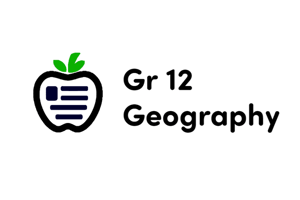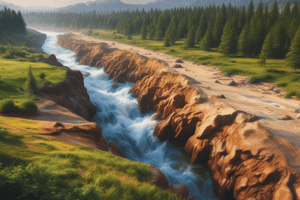Podcast
Questions and Answers
What is the main process involved in water erosion?
What is the main process involved in water erosion?
Which type of erosion widens channels and alters river morphology?
Which type of erosion widens channels and alters river morphology?
What is the most pronounced form of river erosion during large flood events?
What is the most pronounced form of river erosion during large flood events?
In river erosion, what can high-energy rivers do to infrastructure near them?
In river erosion, what can high-energy rivers do to infrastructure near them?
Signup and view all the answers
Which type of erosion occurs underground within aquifers?
Which type of erosion occurs underground within aquifers?
Signup and view all the answers
What poses threats to infrastructure built near rivers due to river erosion?
What poses threats to infrastructure built near rivers due to river erosion?
Signup and view all the answers
What is the main mechanism of groundwater erosion described in the text?
What is the main mechanism of groundwater erosion described in the text?
Signup and view all the answers
How does groundwater erosion indirectly contribute to the formation of caves and sinkholes?
How does groundwater erosion indirectly contribute to the formation of caves and sinkholes?
Signup and view all the answers
What is a significant impact of river erosion on aquatic ecosystems?
What is a significant impact of river erosion on aquatic ecosystems?
Signup and view all the answers
How does groundwater erosion affect agricultural productivity?
How does groundwater erosion affect agricultural productivity?
Signup and view all the answers
Which statement best describes the long-term impact of water erosion on waste management practices?
Which statement best describes the long-term impact of water erosion on waste management practices?
Signup and view all the answers
What type of measures are necessary to mitigate escalating water erosion risks due to climate change?
What type of measures are necessary to mitigate escalating water erosion risks due to climate change?
Signup and view all the answers
Study Notes
Water Erosion: Shaping Landscapes through Rivers and Groundwater
Water is a powerful force that continuously shapes our planet's surface, resculpting landscapes over thousands of years through various geomorphological processes—one such process being water erosion. This phenomenon involves the detachment and movement of soil particles by running water, whether it flows aboveground in rivers or underground within aquifers. Here we delve into the intricacies of two main types of water erosion—river erosion and groundwater erosion—and examine their consequences on ecosystems and human societies.
River Erosion
River erosion occurs when flowing streams dislodge sedimentary material from banks and degrade land surfaces, thereby widening channels and altering river morphology. This type of erosion has significant impacts on both natural environments and human settlements located near rivers. In areas where vegetation and protective barriers have been removed, high-energy rivers can carve deep gorges and cause severe bank collapses known as slump failures, posing threats to infrastructure built alongside them like roads, bridges, and houses.
The most pronounced form of river erosion, commonly seen during large flood events, is channel widening. When the flow velocity increases due to heavy precipitation, glacier melt, or structural dam failure, it overpowers the resistance of the stream bed. As a result, the channel spreads outward with time, gradually engulfing its surrounding landscape with freshly exposed soils.
Groundwater Erosion
Groundwater erosion, also termed subsurface or piping erosion, results from slow seepage of water along confined fractures and pathways, leading to the dissolution and displacement of unconsolidated materials beneath the earth's surface. Unlike river erosion, this mechanism does not affect directly visible features; however, it contributes significantly to mass transport below the land surface.
In arid regions, shallow wells installed for irrigation purposes may encounter groundwater erosion problems if they penetrate sand layers saturated with subterranean streams. Over time, these continuous flows excite chemical weathering reactions causing the collapse of porous sands and subsequent subsidence of the affected area. In addition, groundwater erosion can contribute indirectly to the formation of caves and sinkholes, ultimately affecting local topography and threatening infrastructure stability.
Effects of Water Erosion
Both river erosion and groundwater erosion have profound implications for ecosystem health and economic development. For instance, accelerated channel incision caused by excessive runoff might lead to reduced aquatic habitats and increased sediment load entering sensitive aquatic ecosystems. Consequently, fish populations and other organisms dependant upon clear waters will be adversely impacted. On the other hand, groundwater erosion compromises agricultural productivity, jeopardizes drinking water quality, and threatens the integrity of critical engineering structures. Moreover, eroded soils, mobilized by either mechanical or hydraulic means, pose challenges to waste management practices by increasing leaching rates and reducing treatment efficiency.
As climate change intensifies rainfall patterns, seasonal extremes, and snowmelt dynamics, water erosion risks are anticipated to escalate worldwide. Mitigating measures must entail multidisciplinary approaches encompassing sustainable land use planning, improved crop management strategies, enhanced soil conservation techniques, efficient urban drainage systems, and active monitoring efforts to minimize environmental harm while preserving life-supportive ecosystem services.
Studying That Suits You
Use AI to generate personalized quizzes and flashcards to suit your learning preferences.
Description
Explore the significant role of water erosion in shaping landscapes through rivers and groundwater, affecting ecosystems and human settlements. Learn about river erosion causing gorges and channel widening, and groundwater erosion leading to subsidence and cave formation. Delve into the consequences of water erosion on ecosystem health and economic development, alongside mitigation strategies to combat its impacts.




